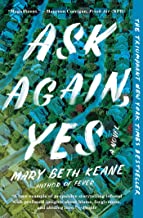Ask Again, Yes by Mary Beth Keane
What's It About?
I loved this moving story of young love, family trauma and the aftermath…it kept me engrossed until the very last page.Two young policemen work together in Brooklyn in the 1970s. To distance themselves from the job and start families they both move to the suburbs with their wives and end up living next door. Francis and Lena have three daughters. Brian and Anne have a son, Peter. Peter develops a strong connection with one of the three daughters, Kate, yet the families don’t socialize, mostly because Anne’s behavior is a little odd.
A tragic event occurs…no spoilers here…and relationships become strained and crumble under the stress. Can we find the way back to the people who are important to us? A gripping new novel with deep characters and an accurate portrayal of the working class, Ask Again, Yes (Scribner) by Mary Beth Keane is a must-read!
Q & A with author Mary Beth Keane:
Jennifer Blankfein: Can you tell me a little about your process of writing and organizing this novel. Did you know the path each character would take individually or did it come together as you wrote?
Mary Beth Keane: I started the novel seeing only two of the characters. Francis, and Peter. I knew Peter was a child and Francis was new to the NYPD, but I didn’t know what they had to do with one another for a long time. I began by writing them separately, and then placing them alongside each other, if that makes sense. Eventually it became clear how these families would have an impact on one another. I never write my books in order, from beginning to end. For example, there’s a scene where Peter slides down a telephone pole. In the final draft, it’s a memory being recollected. But that was one of the first scenes I wrote when I began this book.
Two neighbors have a childhood friendship that ultimately turns to love, and even though they are kept apart for some time, they find each other again. What inspired you to create this relationship the reader is hoping for?
I knew that they would be childhood friends, and I knew they would find each other again as adults. I also knew they had quite different approaches to life thanks to the environments in which they were raised. I don’t outline, but I did know that much. I did NOT know what form their reconnection would take: whether they’d just meet up once and move on or what. The point of the book, if there is a point, is about the randomness of life, and how our lives touch and change other lives even when we don’t mean them to.
Anne Stanhope’s erratic behavior was due to mental illness, and her husband Brian, his brother George and her son Peter battled alcohol addiction. Their struggles were painful and actions seemed realistic…how did you prepare to write such complicated characters?
I pull partly from life and partly from my imagination. By middle age most people know someone who has struggled with addiction, whether they know it or not. All I need is a spark from real life and then I can run with it and imagine all the possible outcomes. The thrill of fiction writing is following one possible outcome to its conclusion.
Peter is estranged from his mother – how did you research this idea of being out of touch with a parent?
My husband, who I met when we were in high school, was estranged from his parents for many years. His mother died during that estrangement. Explaining that break to our children, who never met their grandmother, was part of the reason I was driven to write this particular book. Is a parent always a parent? Does being someone’s mother or father or child always have particular meaning, or does that meaning get lost when the relationship is severed?
Guns and unnecessary shootings are in the news all the time. Do you think Brian, a police officer, was careless or did he consciously make the decision to be lax?
No, he was just being careless. These were the years before Columbine, so even when that gun showed up where it shouldn’t have, people didn’t yet think immediately of a mass shooter like they would today. I talked to a lot of police officers while writing this book and that was something that came up more than once, stories of off-duty police officers losing track of their off-duty weapons, especially in the 1970s and 1980s.
Did you know how the book was going to end when you started writing it?
Ha! No. Not even remotely.
Did you change anything significant during the revision process?
Oh yes! So much that I couldn’t possibly answer fully here. I started the book from Kate’s point of view, written in the first person. I scrapped that after about one hundred pages. I changed the structure many, many times. I spent a very long time starting with Peter and Kate as adults, and then looping back to their childhoods, but that felt impossible to pull off without bogging down the narrative with flashback. It took a long time to figure out how to best tell this particular story.
Can you share any information about Ask Again, Yes for TV and Film?
Just that I’m thrilled, and that it’s happening. Right now it seems most likely to be a limited mini-series, and I’m delighted by that. I love that a limited mini-series will provide enough room and time to really tell this story in detail.
What have you read lately that you recommend?
I just finished All We Shall Know by Donal Ryan and I’m completely gutted. It was devastating and brilliant.
Ask Again, Yes is now available for purchase.





